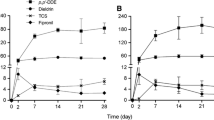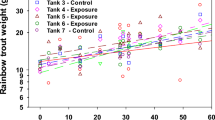Abstract
Radiolabeled tri-, tetra-, and pentachlorobiphenyls (PCB) and DDE were studied in a laboratory model ecosystem for degradation pathways, and biomagnification in alga, snail, mosquito, and fish. Trichlorobiphenyl was degraded in all the organisms of the model ecosystem much more rapidly than tetrachloro- and pentachlorobiphenyl. Pentachlorobiphenyl was approximately as persistent as DDE. There was a linear relationship between lipid/water partition and ecological magnification and between water solubility and ecological magnification. No evidence of conversion of DDE to PCB was detected.
Similar content being viewed by others
References
Costs, J. R., R. L. Metcalf, and I. P. Kapoor: Metabolism of the methoxychlor isostere, dianisylneopentane in mouse, insects, and a model ecosystem. Pesticide Biochem. Phyaol.4, 201 (1974).
Datta, P. R.:In vivo detoxication ofp,p′-DDT viap,p′-DDE top,p′-DDA in rats. Ind. Med.39, 190 (1970).
Hamelink, J. L., R. C. Waybrant, and R. C. Ball: A proposal: exchange equilibria control the degree chlorinated hydrocarbons are biologically magnified in lentic environments. Trans. Am. Fisheries Soc.100, 207 (1971).
Hutzinger, O., D. M. Nash, S. Safe, A. S. W. DeFreitas, R. J. Norstrom, D. J. Wildish, and V. Zikkos: Polychlorinated biphenyls: metabolic behavior of pure isomers in pigeons, rats, and brook trout. Science178, 312 (1972).
Kapoor, I. P., R. L. Metcalf, A. S. Hirwe, J. R. Coats, and M. S. Khalsa: Structure activity correlations of biodegradability of DDT analogs. J. Agr. Food Chem.21, 310 (1973).
Kapoor, I. P., R. L. Metcalf, A. S. Hirwe, Po-Yung Lu, J. R. Coats, and R. F. Nystrom: Comparative metabolism of DDT, methylchlor, and ethoxychlor in mouse, insects, and in a model ecosystem. J. Agr. Food Chem.20, 1 (1972).
Kapoor, I. P., R. L. Metcalf, R. F. Nystrom, and G. K. Sangha: Comparative metabolism of methoxychlor, methylchlor, and DDT in mouse, insects and in a model ecosystem. J. Agr. Food Chem.18, 1145 (1970).
Kelly, R. G., E. A. Peets, S. Gordon, and D. A. Buyske: Determination of14C and3H in biological samples by Schöniger combustion and liquid scintillation technique. Anal. Biochem2, 267 (1961).
Kerner, I., W. Klein, and F. Korte: Photochemische Reactionen von 1,1-dichloro-2-(p,p-dichloroethylene) DDE. Tetrahedron28, 1575 (1972).
Lu, Po-Yung, and R. L. Metcalf: Degradation and environmental fate of radiolabeled benzene derivatives in a model aquatic ecosystem. Ms. in preparation.
Maugh, T. H. II: DDT: An unrecognized source of polychlorinated biphenyls. Science180, 578 (1973).
Metcalf, R. L., G. M. Booth, C. K. Schuth, D. J. Hansen, and Po-Yung Lu: Uptake and fate of di-2-ethylhexyl phthalate in aquatic organisms and in a model ecosystem. Environ. Health Persp. Experi. Issue4, 27 (1973b).
Metcalf, R. L., I. P. Kapoor, Po-Yung Lu, C. K. Schuth, and P. Sherman: Model ecosystem studies of the environmental fate of six organochlorine pesticides. Environ. Health Persp. Experi. Issue4, 35 (1973a).
Metcalf, R. L., G. K. Sangha, and I. P. Kapoor: A laboratory model ecosystem. Environ. Sci. Technol.5, 709 (1971).
Metcalf, R. L., Po-Yung Lu, and I. P. Kapoor: Environmental distribution and metabolic fate of key industrial pollutants and pesticides in a model ecosystem. Univ. Ill. Water Resources Center,Rept. No. 69, Project B-050 Ill. (1973).
Moilanen, K. W., and D. G. Crosby: Vapor-phase photodecomposition of p,p′-DDT and its relatives. Abst. No. 27 (1973) 165th Meeting American Chemical Society.
Peakall, D. B., and J. L. Lincer: Polychlorinated biphenyls, another long-life widespread chemical in the environment. Bioscience20, 958 (1970).
Plimmer, J. R., U. I. Klingelbiel, and B. E. Hummer: Photooxidation of DDT and DDE. Science167, 67 (1970).
Risebrough, R. W., P. Rieche, D. B. Peakall, S. G. Herman, and M. N. Kirven: Polychlorinated biphenyls in the global ecosystem. Nature220, 1098 (1968).
Sodergren, A.: Transport, distribution, and degradation of chlorinated hydrocarbon residues in aquatic model ecosystems. Oikos24, 30 (1973).
Wallnofer, P. R., G. Engelhardt, S. Safe, and D. Hutzinger: Microbial hydroxylation of 4-chlorobiphenyl and 4,4′-dichlorobiphenyl. Chemosphere2, 69 (1973).
Webb, R. G., and A. C. McCall: Identities of polychlorinated biphenyl isomers in Aroclors. J. Assoc. Offic. Agr. Chem.55, 746 (1972).
Yoshimura, H., and H. Yammamoto: Metabolic studies on polychlorinated biphenyls III. Complete structure and acute toxicity of the metabolites of 2,4,3′,4′-tetra-chlorobiphenyl. Chem. Pharm. Bull. (Japan)21, 2239 (1973).
Author information
Authors and Affiliations
Rights and permissions
About this article
Cite this article
Metcalf, R.L., Sanborn, J.R., Lu, PY. et al. Laboratory model ecosystem studies of the degradation and fate of radiolabeled tri-, tetra-, and pentachlorobiphenyl compared with DDE. Arch. Environ. Contam. Toxicol. 3, 151–165 (1975). https://doi.org/10.1007/BF02220785
Received:
Accepted:
Issue Date:
DOI: https://doi.org/10.1007/BF02220785




